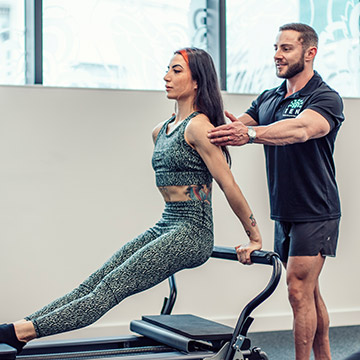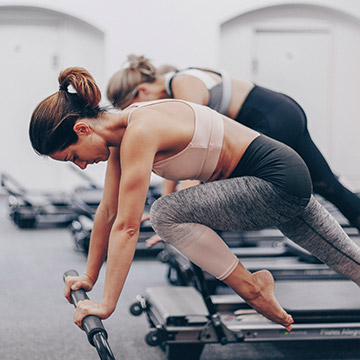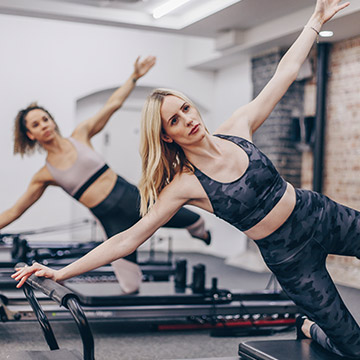Why come to a Reformer Pilates Transition class?
We know that the idea of stepping up a level can be intimidating, but it doesn’t have to be – and we’re here to help.
Whether you’re preparing for Intermediate or Advanced level, our transition classes are designed to introduce you to the exercises, progressions and level of difficulty you’ll be facing. But we do it a slower pace, and with more time and focus spent on getting set up properly and making sure you’re performing the movements correctly.
Are Transition classes right for me?
Beginners to Intermediate
Designed for anyone who’s been taking Beginners classes for a while
and is thinking about stepping up to Intermediate, but may be a little
nervous about the transition, or unsure if they’re quite ready.
Intermediate to Advanced
If you’re comfortable attending Intermediate classes and regularly
take the harder progressions when they’re offered, but unsure about
what to expect from an Advanced class, this is definitely the session for you.
It’s also a great reintroduction for Advanced clients who are coming back
to this level of class after some time off.
What will a Reformer Pilates Transition class be like?
Beginners to Intermediate
Slower paced than a typical Intermediate class, you’ll build from the moves and techniques you’re already
comfortable with to introduce more challenging progressions. Your trainer will also take more time on the
cues and set-up whilst offering additional support and hands on correction if you need it.
Intermediate to Advanced
It will feel more like a workshop than a class in approach. It will be little slower-paced and more
explanatory than a regular Advanced class (though you’ll still challenge yourself). We’ll introduce you to some
advanced-level exercises, along with next-level progressions of familiar sequences, breaking down the exercises
to make sure you’re safe and comfortable performing them. We’ll also focus on optimal form and technique.

Results & Benefits
Whichever transition class you opt for, you’ll learn how familiar exercises are transformed into a next-level progression. You’ll also be introduced to some new exercises that will feature regularly in the new level of classes.
The slightly slower pace and greater attention to set-up and technique will help you build confidence around new progressions and exercises.
And last but by no means least, you’ll become more confident in what your body is capable of and will be more comfortable challenging yourself further at the next level.
View classesFAQ’s
-
How do I know when I’m ready to move up a level?
There’s no hard and fast answer to this. It will depend on a few factors, including your fitness level, how often you train, your exercise and injury history, and how much you want to push yourself. If you’re not sure, at the start of your next class ask your instructor to keep an eye on you during the session and let you know afterwards if they think you’re ready to move up to the next level.
Beginners to Intermediate
Some people are ready to step up to Intermediates after just a handful of classes, while others find they’re happy sticking with Beginners classes for several months. Either way you must do at least one Beginners class before your first Intermediate. Generally speaking, you’re ready to move up a level if you’re comfortable with the Reformer, can complete a Beginners Class without having to stop or reset too often, and still have a little bit left to give at the end of the class.
Intermediates to Advanced
Advanced classes are unapologetically challenging in terms of both intensity and technique. You’ll need to be a strong Intermediate before stepping up to these classes. So you’ll need to be comfortable with the Intermediate-level exercises, regularly take the harder progressions without having to reset too often, and still feel like you have a bit left in the tank. Additionally, if you feel your progress has plateaued in Intermediate Classes, that’s often the sign that you’re ready for the next level. -
What’s difference between the exercises at each level?
Beginners to Intermediate
Intermediate Classes are designed to push the body a little harder and increase your strength and endurance. The biggest differences are in pace and intensity – there are more exercises per class than in a Beginners, the movements are harder, there are fewer rests and the transitions between exercises are faster. You should be comfortable with the fundamentals, so we can safely increase the complexity and intensity of the movements and add additional loads, with weights and more challenging spring options.Expect a mix of exercises – some will be new to you, others will be familiar – except with some new progressions and spring selections that will challenge your strength, technique and balance and push you that bit harder.
Intermediates to Advanced
Advanced classes are a mix of familiar exercises – with harder progressions and more challenging spring settings to increase the load and intensity of the flows – and some new exercises which will challenge your balance, technique, strength and stamina (or all four) more than the exercises you’ve previously been doing. -
How much harder is the next level?
Beginners to Intermediate
It’s definitely a step up. It’s a tougher workout and will challenge your strength, balance and stamina more than a Beginners class will. You’ll get through more exercises per class, and you’ll be expected to get set up for them faster. If you find yourself struggling a bit – everyone should expect to have to reset from time to time – don’t worry. Your instructor can give you easier options or adaptations if you’re having trouble with a particular exercise.
Intermediates to Advanced
It’s an unapologetically challenging workout designed to challenge your strength, control and endurance – so definitely a jump up in pace, technique, complexity and intensity from Intermediate classes. Classes are faster paced and there are no breaks (you’re expected to judge your own efforts and pause/reset as necessary). Expect the sequences to be more complex, include more compound elements (involving multiple muscle groups at the same time) and overall, more challenging.



